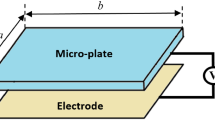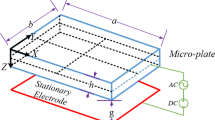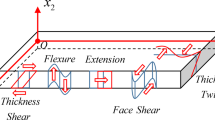Abstract
Besides one dimensional beam-type MEMS, two dimensional electrically actuated rectangular micro-plates have lots of applications in micro-engineering. However, there exist only a few works devoted to the analysis of such structures in the open literature to date. Therefore, the present work focuses on the dynamic behavior of electrically actuated rectangular micro-plates under mechanical shock. The micro-plate is modeled using the non-linear Kirchhoff plate theory and the shock is assumed to be induced according to the base excitation scheme. The micro-plate motion is simulated through a novel and computationally very efficient reduced order model which accounts for the inherent non-linearity of distributed electrostatic pressure and the geometric non-linearity of von Kármán mid-plane stretching as well as the influences of both in-plane and out-of-plane displacements. The present findings are compared and successfully validated by those obtained through three-dimensional finite element analysis carried out in COMSOL Multiphysics commercial software as well as the available static results in the literature. It is found that the present procedure can remove the long run-time limitation of the finite element method and produce robust results over the whole operation range of the device up to its instability threshold especially for systems subjected to enormous shock accelerations.




Similar content being viewed by others
References
Senturia, S. D. (2001). Microsystem design. Dordrecht: Kluwer Academic Publishers.
Batra, R. C., Porfiri, M., & Spinello, D. (2007). Review of modeling electrostatically actuated microelectromechanical systems. Smart Materials and Structures, 16, 23–31.
Nayfeh, A. H., & Younis, M. I. (2005). Dynamics of MEMS resonators under superharmonic and subharmonic excitations. Journal of Micromechanics and Microengineering, 15, 1840–1847.
Rebeiz, G. M. (2003). RF MEMS: Theory, design, and technology. NewYork: Wiley.
Askari, A. R., & Tahani, M. (2014). An alternative reduced order model for electrically actuated micro-beams under mechanical shock. Mechanics Research Communications, 57, 34–39.
Younis, M. I., Miles, R., & Jordy, D. (2006). Investigation of the response of microstructures under the combined effect of mechanical shock and electrostatic forces. Journal of Micromechanics and Microengineering, 16, 2463–2474.
Younis, M. I., Alsaleem, F., & Jordy, D. (2007). The response of clamped–clamped microbeams under mechanical shock. International Journal of Non-Linear Mechanics, 42, 643–657.
Béliveau, A., Spencer, G. T., Thomas, K. A., & Roberson, S. L. (1999). Evaluation of MEMS capacitive accelerometers. IEEE Design & Test of Computers, 16, 48–56.
Brown, T. G., Davis, B., Hepner, D., Faust, J., Myers, C., Muller, P., et al. (2001). Strapdown microelectromechanical (MEMS) sensors for high-G munition applications. IEEE Transactions on Magnetics, 37, 336–342.
Fan, M. S., & Shaw, H. C. (2001). Dynamic response assessment for the MEMS accelerometer under severe shock loads. In Proceedings of NASA, TP-2001-20997.
Fang, X. W., Huang, Q. A., & Tang, J. Y. (2004). Modeling of MEMS reliability in shock environments. In Proceedings of 7th international conference on solid-state and integrated circuits technology (pp. 860–863).
Younis, M. I. (2011). MEMS linear and nonlinear statics and dynamics. New York: Springer.
Krylov, S. (2007). Lyapunov exponents as a criterion for the dynamic pull-in instability of electrostatically actuated microstructures. International Journal of Non-Linear Mechanics, 42, 626–642.
Abdel-Rahman, E. M., Younis, M. I., & Nayfeh, A. H. (2002). Characterization of the mechanical behavior of an electrically actuated microbeam. Journal of Micromechanics and Microengineering, 12(6), 759–766.
Younis, M. I., Abdel-Rahman, E. M., & Nayfeh, A. H. (2003). A reduced-order model for electrically actuated microbeam based MEMS. Journal of Microelectromechanical systems, 12, 672–680.
Zhao, X., Abdel-Rahman, E. M., & Nayfeh, A. H. (2004). A reduced-order model for electrically actuated microplates. Journal of Micromechanics and Microengineering, 14, 900–906.
Nayfeh, A. H., Younis, M. I., & Abdel-Rahman, E. M. (2005). Reduced-order models for MEMS applications. Nonlinear Dynamics, 41(1), 211–236.
Kuang, J.-H., & Chen, C.-J. (2004). Dynamic characteristics of shaped micro-actuators solved using the differential quadrature method. Journal of Micromechanics and Microengineering, 14(4), 647.
Sadeghian, H., Rezazadeh, G., & Osterberg, P. M. (2007). Application of the generalized differential quadrature method to the study of pull–in phenomena of MEMS switches. Journal of Microelectromechanical Systems, 16(6), 1334–1340.
Jin, C., Jiang, Z., & Xingtao, W. (2004). Analytical and finite element model pull–in study of rigid and deformable electrostatic microactuators. Journal of Micromechanics and Microengineering, 14(1), 57.
Moghimi Zand, M., & Ahmadian, M. T. (2010). Dynamic pull–in instability of electrostatically actuated beams incorporating Casimir and van der Waals forces. Journal of Mechanical Engineering Science, 224(9), 2037–2047.
Tajalli, S. A., Moghimi Zand, M., & Ahmadian, M. T. (2009). Effect of geometric nonlinearity on dynamic pull-in behavior of coupled-domain microstructures based on classical and shear deformation plate theories. European Journal of Mechanics-A/Solids, 28(5), 916–925.
Hung, E. S., & Senturia, S. D. (1999). Generating efficient dynamical models for microelectromechanical systems from a few finite-element simulation runs. Journal of Microelectromechanical Systems, 8(3), 280–289.
Mohsenzadeh, A., Tahani, M., & Askari, A. R. (2015). A Novel Method for Investigating the Casimir effect on pull–in instability of electrostatically actuated fully clamped rectangular nano/microplates. Journal of Nanoscience, 2015, 9.
Tahani, M., Askari, A. R., Mohandes, Y., & Hassani, B. (2015). Size-dependent free vibration analysis of electrostatically pre-deformed rectangular micro-plates based on the modified couple stress theory. International Journal of Mechanical Sciences, 94–95, 185–198.
Tahani, M., & Askari, A. R. (2014). Accurate electrostatic and van der Waals pull–in prediction for fully clamped nano/micro-beams using linear universal graphs of pull–in instability. Physica E: Low-dimensional Systems and Nanostructures, 63, 151–159.
Askari, A. R., & Tahani, M. (2012). Analytical approximations to nonlinear vibration of a clamped nanobeam in presence of the Casimir force. International Journal of Aerospace and Lightweight Structures, 2(3), 317–334.
Askari, A. R., & Tahani, M. (2012). Investigating nonlinear vibration of a fully clamped nanobeam in presence of the van der Waals attraction. Applied Mechanics and Materials, 226–228, 181–185.
Askari, A. R., & Tahani, M. (2016). Stability analysis of electrostatically actuated nano/micro-beams under the effect of van der Waals force, a semi-analytical approach. Communications in Nonlinear Science and Numerical Simulation, 34, 130–141.
Koochi, A., Sedighi, H. M., & Abadyan, M. (2014). Modeling the size dependent pull–in instability of beam-type NEMS using strain gradient theory. Latin American Journal of Solids and Structures, 11, 1806–1829.
Dashtaki, P. M., & Beni, Y. T. (2014). Effects of Casimir force and thermal stresses on the buckling of electrostatic nanobridges based on couple stress theory. Arabian Journal for Science and Engineering, 39(7), 5753–5763.
Beni, Y. T., Koochi, A., & Abadyan, M. (2014). Using modified couple stress theory for modeling the size dependent pull-in instability of torsional nano-mirror under Casimir force. International Journal of Optomechatronics, 8, 47–71.
Tadi Beni, Y., Karimipour, I., & Abadyan, M. (2015). Modeling the instability of electrostatic nano-bridges and nano-cantilevers using modified strain gradient theory. Applied Mathematical Modelling, 39(9), 2633–2648.
Sedighi, H. M., Daneshmand, F., & Abadyan, M. (2015). Modified model for instability analysis of symmetric FGM double-sided nano-bridge: Corrections due to surface layer, finite conductivity and size effect. Composite Structures, 132, 545–557.
Malihi, S., Beni, Y. T., & Golestanian, H. (2016). Analytical modeling of dynamic pull-in instability behavior of torsional nano/micromirrors under the effect of Casimir force. Optik, 127(10), 4426–4437.
Milad, S., Yaghoub Tadi, B., & Hossein, A. (2016). Size-dependent snap-through and pull-in instabilities of initially curved pre-stressed electrostatic nano-bridges. Journal of Physics D: Applied Physics, 49(29), 295303.
Malihi, S., Tadi Beni, Y., & Golestanian, H. (2016). Size dependent pull–in instability analysis of torsional nano/micromirrors in the presence of molecular force using 2D model. Optik, 127(19), 7520–7536.
Malihi, S., Beni, Y. T., & Golestanian, H. (2017). Dynamic pull–in stability of torsional nano/micromirrors with size-dependency, squeeze film damping and van der Waals effect. Optik, 128, 156–171.
Askari, A. R., & Tahani, M. (2017). Size-dependent dynamic pull-in analysis of geometric non-linear micro-plates based on the modified couple stress theory. Physica E: Low-dimensional Systems and Nanostructures, 86, 262–274.
Français, O., & Dufour, I. (1999). Normalized abacus for the global behavior of diaphragms: Pneumatic, electrostatic, piezoelectric or electromagnetic actuation. Journal of Modeling and Simulation of Microsystems, 1(2), 149–160.
Batra, R. C., Porfiri, M., & Spinello, D. (2008). Reduced-order models for microelectromechanical rectangular and circular plates incorporating the Casimir force. International Journal of Solids and Structures, 45, 3558–3583.
COMSOL Multiphysics, Version 5.2a, Burlington, MA 01803 (2016). http://www.comsol.com. Accessed Jan 2018.
Reddy, J. N. (2007). Theory and analysis of elastic plates and shells (2nd ed.). Philadelphia: Taylor & Francis.
Yeh, C.-L., & Lai, Y.-S. (2006). Support excitation scheme for transient analysis of JEDEC board-level drop test. Microelectronics Reliability, 46(2–4), 626–636.
Reddy, J. N. (2002). Energy principles and variational methods in applied mechanics. New York: Wiley.
Gutschmidt, S. (2010). The influence of higher-order mode shapes for reduced-order models of electrostatically actuated microbeams. Journal of Applied Mechanics, 77(4), 0410071–0410076.
Amabili, M. (2004). Nonlinear vibrations of rectangular plates with different boundary conditions: theory and experiments. Computers & Structures, 82(31–32), 2587–2605.
Faires, J. D., & Burden, R. L. (2002). Numerical methods (3rd ed.). Pacific Grove: Brooks/Cole.
Askari, A. R. (2018). The influence of higher in- and out-of-plane natural modes on dynamic pull-in instability of electrically actuated micro-plates. European Journal of Computational Mechanics. https://doi.org/10.1080/17797179.2018.1484032. (In Press).
JEDEC Solid State Technology Association. (2001). JESD22-B110: Subassembly Mechanical Shock. VA: Arlington.
Arenas, J. P. (2003). On the vibration analysis of rectangular clamped plates using the virtual work principle. Journal of Sound and Vibration, 266, 912–918.
Osterberg, P. M. (1995). Electrostatically actuated microelectromechanical test structures for material property measurement. Cambridge: Massachusetts Institute of Technology.
Author information
Authors and Affiliations
Corresponding author
Rights and permissions
About this article
Cite this article
Askari, A.R., Tahani, M. Dynamic Analysis of Rectangular Micro-plates Under Mechanical Shock in Presence of Electrostatic Actuation. Sens Imaging 19, 31 (2018). https://doi.org/10.1007/s11220-018-0215-x
Received:
Revised:
Published:
DOI: https://doi.org/10.1007/s11220-018-0215-x




